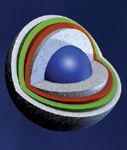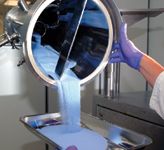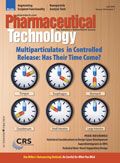The Hour of the Particle
Is now the time for multiparticulates to shine as a controlled-release solution?
Patents on many popular medicines will soon expire, and makers of generic drugs threaten to reduce Big Pharma's profits by marketing low-cost versions of these therapies. Because the industry's pipelines remain anemic, many companies have sought to extend the patents on their products by developing new controlled-release formulations. Multiparticulate dosage forms could extend patent protection, offer great control over release rates, and expand drugmakers' formulation options.
The particulars of multiparticulates
Multiparticulates is a general term for roughly spherical pellets that have diameters of approximately 0.25 to 3 mm. These pellets may contain one or more active pharmaceutical ingredients (APIs), or they may consist of inert cores coated with APIs. Multiparticulates release their drug loads independently. They can be compressed into tablets, filled into hard gelatin capsules or sachets, or mixed into liquid oral suspensions.

WOOD IMAGE: AMANALIMAGESRF, GETTY IMAGES. PILLS: BALLY SCANION, DIGITAL VISION, GETTY IMAGES. SWISS CLOCK: GREGOR SCHUSTER, GETTY IMAGES. REGULAR CLOCK: STOCKBYTE, GETTY IMAGES.
Minitabs, one type of multiparticulate, are tablets with diameters of between 2 and 3 mm. They can be filled into hard capsules, administered as single units, or compacted into bigger tablets that release their subunits as multiple dosage forms upon disintegration.
Multiplying the means of control
Multiparticulates can control a drug's release rate by mechanisms similar to those used in conventional controlled-release tablets. For example, a multiparticulate can release its drug load as it erodes in the gastrointestinal (GI) tract. This technique is appropriate for low-dose or low-solubility drugs. "The formulation of the particulate core can become rather sophisticated to provide a customizable release profile," says David Oakley, director of technical sales for oral dosage forms at AAIPharma (Wilmington, NC). Formulators can include permeation enhancers, buffers, or solubilizers in the pellets, for example.

Elan Drug Technologies's SODAS multiparticulate contains an active-pharmaceutical-ingredient core coated with layers of functional polymers that control the drug's release rate. (IMAGE IS COURTESY OF ELAN)
But the most common approach to controlling multiparticulates' release profiles is to apply functional coatings to the pellets, says Oakley. Coatings often are selected to provide sustained or delayed release. The coating formulation can be modified to form pores through which the drug can diffuse. Manufacturers can achieve sophisticated release profiles by applying multiple coatings.
Enteric polymers such as methacrylic acid copolymer and hydroxypropyl methylcellulose phthalate protect pellets as they travel through the stomach, but dissolve in the near-neutral pH environment of the upper small intestine. Aqueous media can permeate ethyl cellulose and ammonio methacrylate copolymer coatings, thus allowing the drug to be transported from the multiparticulate, says Joe Cobb, senior formulation scientist at Metrics (Greenville, NC). Manufacturers can also coat pellets with an insoluble barrier membrane through which the drug diffuses from inside the core into the surrounding medium. Changing the coating levels or the combination of polymers that coat the multiparticulate allows the creation of complex release profiles.
The Micropump system is Flamel Technologies's (Venissieux, France) method of creating multiparticulate dosage forms. The company surrounds an inert core with an API and coats the multiparticulate with various polymers to achieve the desired controlled-release properties. The system produces multiparticulates that can be used in liquid oral suspensions. The coating that the company applies to multiparticulates withstands long-term storage in liquid suspension without any change in its permeability, says Catherine Castan, Flamel's director of research and development of oral dosage forms. Coreg CR, GlaxoSmithKline's (London) controlled-release formulation of carvedilol, uses Flamel's Micropump technology, she adds.

An operator at Flamel Technologies empties Micropump coated multiparticulates from a fluid bed onto a tray. (IMAGE IS COURTESY OF FLAMEL TECHNOLOGIES)
Although multiparticulates and tablets share similar methods for controlling drug release, multiparticulate systems offer a higher degree of flexibility in dosage-form design and development than tablets do. "Each subunit in a multiparticulate system contains part of the drug, and the sum of the drug in all subunits makes the total dose, but the functionality of the overall dose is directly correlated to the functionality of individual subunits," says Ali Rajabi-Siahboomi, senior director of scientific affairs at Colorcon (Harleysville, PA). By filling capsules with multiparticulates that release the same drug at various rates, drugmakers have the flexibility to create an array of dosage forms—from simple to complex, tailored release profiles.
Making multiparticulates
Companies can choose among various techniques to manufacture multiparticulates. The simplest manufacturing technique is to layer the liquid drug onto inert spherical particles made of sugar or microcrystalline cellulose, says Orapin Rubino, director of formulation and product development at Glatt Pharmaceutical Services (Ramsey, NJ). In this strategy, which is appropriate for drug loads that are less than approximately 50% w/w, manufacturers use a Wurster column attachment on a fluid-bed processor.
Another common manufacturing method relies on extrusion and spheronization. First, operators force a blended, wet mass of drug and excipients through a porous plate with an extruder. Then the fragments are loaded onto a revolving disk with a chosen surface roughness, and the disk's rotation forms rounded pellets, says Oakley. Manufacturers can coat the multiparticulates or leave them uncoated and fill them into capsules. This method is appropriate for drug loads as high as 90% w/w.
Other common manufacturing techniques include direct pelletization and spray drying. Manufacturers also have developed advanced techniques such as spray congealing, but they are not yet widely used, says Rubino.
In hot-melt spray congealing, scientists melt a waxy polymer and mix an API into it, says Jochen Farrenkopf, group leader in pharmaceutical development of solid dosage forms at Abbott (Chicago). The API must be thermally stable enough to withstand the polymer's melting temperatures of 60–70 °C. Droplets of this molten mixture fall onto a fast-rotating disc and are dispersed into fine particles that solidify as they travel, within several centimeters. These fine particles become spherical multiparticulates that can be encapsulated and used for modified release.
Minitabs can be manufactured relatively easily with special tooling using standard tablet presses and compression forces. At its contract-manufacturing facility in Ludwigshafen, Germany, Abbott uses a punch that incorporates 19 2-mm tips, says Farrenkopf. Using this tooling requires understanding and experienced operators. Because the 19 small punches have a lot of surface area, operators must set the tooling up thoroughly and be sensitive to its relatively high punch–die friction. Operators also must be careful not to break the 2-mm punches by subjecting them to too much compression. Although this manufacturing process requires care, "it's a pretty stable and forgiving technique that is feasible for long-term commercial manufacture," says Farrenkopf.
Machines that fill multiparticulates and minitablets into capsules are readily available to pharmaceutical manufacturers. IMA's (Bologna, Italy) Adapta encapsulator can fill as many as five ingredients into each capsule and check the dosing of each individual product. Operating the unit requires no special training or maintenance.
Putting multiparticulates to work
Because they are small and easy to swallow, multiparticulates are particularly suited to geriatric formulations. If a patient breaks a tablet in half so that he or she can swallow it more easily, the tablet's coating layer often is compromised and it can no longer provide controlled drug release. Multiparticulates avoid this difficulty because they are small enough for geriatric patients to swallow them easily. These pellets thus are appropriate for treating conditions that impair swallowing such as Parkinson's disease, Alzheimer's disease, and amyotrophic lateral sclerosis, says Oakley.
For similar reasons, multiparticulates also are suitable for pediatric formulations, for which prescription spending increased 10.8% in 2009 (1). Because multiparticulates are one of the best ways of enabling pediatric formulations, the number of drugs brought to market in this form will surely rise, says Farrenkopf.
Since multiparticulates enable good control of drug release, the dosage form is becoming more popular for drugs that treat chronic conditions. For these reasons, cardiovascular drugs and blood-pressure medicines could benefit from multiparticulates, says Castan.
Multiparticulates' advantages
Multiparticulates' size enables them to provide "considerable clinical advantages," says Gurvinder Singh Rekhi, senior director of oral controlled release at Elan Drug Technologies (Gainesville, GA) and member of the Pharmaceutical Technology editorial board. Because the dose is divided into many subunits, multiparticulates have a much lower risk of dose dumping than tablets do. And single doses that are released accidentally (e.g., by fat) may cause higher incidence of adverse events, compared with multiple units, says Singh.
Dividing a dose into many multiparticulates helps distribute the drug slowly, evenly, and consistently. At any given time, multiparticulates are present in the stomach, the intestine, and other sites in the GI tract, which helps maximize drug absorption. Because multiparticulates provide smooth transit through the GI tract and are less dependent on gastric emptying, they greatly reduce the variability between patients' plasma profiles. Also, multiparticulates' size limits the exposure of the drug to the epithelium and reduces the possibility of irritating the GI tract and the bowel, says Castan.
In addition, multiparticulates can allow drugmakers to provide patients with individualized dosing. For example, a company could package the pellets in a device that patients press to dispense individualized doses. A patient thus could take the appropriate dose for his or her weight or age group. And a dosage form that included instant- and extended-release multiparticulates could improve compliance by reducing the number of doses the patient must take each day.
Multiparticulates can be used to improve convenience and patient compliance, too. For example, a manufacturer might choose to develop a formulation as a traditional tablet because it would allow the company to reach the patient relatively quickly. Afterward, the manufacturer could develop a multiparticulate dosage form of the same drug to provide modified release for increased bioavailability or once-daily application.
In addition, multiparticulates have various advantages for pharmaceutical companies. For instance, drugmakers can combine APIs that otherwise would be chemically incompatible by creating multiparticulates of various formulations and encapsulating them. Also, materials that are not compressible enough to be manufactured as traditional tablets often can be made into minitabs, says Farrenkopf.
The challenges of multiparticulates
Multiparticulates have disadvantages as well. Process development for multiparticulates is more complex than for standard tablets. Additional steps such as particle coating, extrusion, and sizing add to process complexity. For the same reason, multiparticulates also are more difficult and more expensive to manufacture than standard tablets. Some aspects of manufacturing minitabs such as flowing powders into the small dies represent a technological challenge.
It makes sense to choose a multiparticulate approach for applications such as pediatric drugs, multidrug dosage forms, and dosage forms that combine an initial burst with controlled release, says Farrenkopf. Otherwise, multiparticulates' complexity likely would prompt manufacturers to consider simpler dosage forms such as standard monolithic matrix tablets or bilayer tablets, as long as they can accomplish the same objective.
A look to the future
Advances within the industry are making it easier for drugmakers to surmount the challenges of developing and producing multiparticulates, however. The emergence of technologies such as melt granulation has increased the number of manufacturing options and expanded the kinds of drugs that can be made as multiparticulates. "Expertise has become more widespread in the industry and is no longer confined to a few innovators," says Oakley. "Pelletized drug products have become a viable option," he adds.
Recent history could indicate that multiparticulates are poised to become more popular with pharmaceutical manufacturers. "We saw a steady increase in the number of projects using multiparticulates, especially in the past five years," says Rubino. Multiparticulates are attractive to pharmaceutical companies looking for new dosage forms for their existing drugs. They can enable line extensions that could yield drugmakers more revenue, she adds. Developing multiparticulate dosage forms also could provide commercial differentiation for a product and present a market barrier to competing companies.
In addition, firms are coming to appreciate the flexibility that the dosage form offers them. Multiparticulates enable companies to create various strengths of a given drug more easily than is possible with traditional tablets. Because they permit drugmakers to create a wide array of release profiles and to combine otherwise incompatible drugs within one dosage form, multiparticulates expand the formulation possibilities for many active pharmaceutical ingredients.
In addition, the clinical advantages of multiparticulate delivery have increased their popularity with manufacturers and patients alike. Particulate-filled capsules and tablets are highly accepted and often preferred by patients, who view them as a more advanced technology than conventional compressed tablets, says Oakley.
The commercial advantages, flexibility in formulation, clinical improvements, and patient acceptance that multiparticulates entail make it likely that the pharmaceutical industry will pursue this dosage form more actively for its new and established drugs in the coming years.
Reference
1.Medco Health Solutions, 2010 Drug Trend Report: Solving the Healthcare Cost/Quality Equation (Medco, Franklin Lakes, NJ, 2010), p. 30.

Drug Solutions Podcast: A Closer Look at mRNA in Oncology and Vaccines
April 30th 2024In this episode fo the Drug Solutions Podcast, etherna’s vice-president of Technology and Innovation, Stefaan De Koker, discusses the merits and challenges of using mRNA as the foundation for therapeutics in oncology as well as for vaccines.